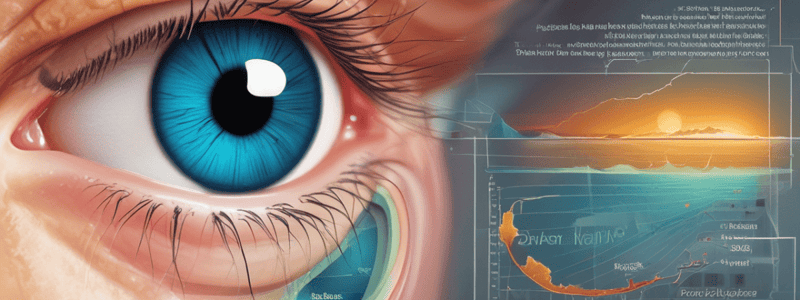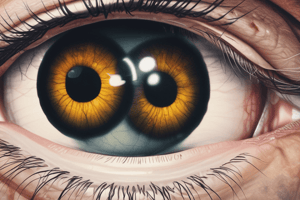Podcast
Questions and Answers
What is the main characteristic of glaucoma according to Hitchings' definition?
What is the main characteristic of glaucoma according to Hitchings' definition?
- Deformations of the optic nerve head (correct)
- Increased ocular hypertension
- Elevated IOP
- Abnormal corneal thickness
What is the typical IOP overlap between patients with glaucoma and normals?
What is the typical IOP overlap between patients with glaucoma and normals?
- Large overlap (correct)
- No clear pattern
- Small overlap
- No overlap
What is the approximate prevalence of normo-tensive POAG in people over 40 years old?
What is the approximate prevalence of normo-tensive POAG in people over 40 years old?
- 0.6% (correct)
- 1.4%
- 2.5%
- 3.5%
What is the principle underlying applanation tonometry?
What is the principle underlying applanation tonometry?
What is the average thickness of the human cornea?
What is the average thickness of the human cornea?
What percentage of referrals are typically deflected due to applanation tonometry?
What percentage of referrals are typically deflected due to applanation tonometry?
What is the maximum acceptable difference in IOP measurement from the assessor's result?
What is the maximum acceptable difference in IOP measurement from the assessor's result?
What is the effect on IOP measurement when the cornea is steeper than average?
What is the effect on IOP measurement when the cornea is steeper than average?
What is the normal diurnal variation in IOP?
What is the normal diurnal variation in IOP?
What is the risk of glaucomatous field loss with IOP > 21 mmHg?
What is the risk of glaucomatous field loss with IOP > 21 mmHg?
What is the effect of lid squeezing or finger pressure on IOP measurement?
What is the effect of lid squeezing or finger pressure on IOP measurement?
What is the effect of corneal astigmatism on IOP measurement?
What is the effect of corneal astigmatism on IOP measurement?
What is the normal inter-eye IOP asymmetry?
What is the normal inter-eye IOP asymmetry?
How often should the Goldmann applanation tonometer be calibrated?
How often should the Goldmann applanation tonometer be calibrated?
What is the effect of breath-holding on IOP measurement?
What is the effect of breath-holding on IOP measurement?
What is the recommendation for patients with IOP > 21 mmHg?
What is the recommendation for patients with IOP > 21 mmHg?
What is the ideal applanation diameter for accurate results in contact tonometry?
What is the ideal applanation diameter for accurate results in contact tonometry?
What is the purpose of the fluorescein in contact tonometry?
What is the purpose of the fluorescein in contact tonometry?
What is the conversion factor used to convert the weight reading to intraocular pressure?
What is the conversion factor used to convert the weight reading to intraocular pressure?
What is the significance of the limbus shining with light during contact tonometry?
What is the significance of the limbus shining with light during contact tonometry?
What is the purpose of adjusting the tension dial during contact tonometry?
What is the purpose of adjusting the tension dial during contact tonometry?
What is the consequence of moving the slit-lamp too far toward the patient during contact tonometry?
What is the consequence of moving the slit-lamp too far toward the patient during contact tonometry?
What is the significance of the meniscus rings in contact tonometry?
What is the significance of the meniscus rings in contact tonometry?
What is the competency requirement for hygiene in contact tonometry?
What is the competency requirement for hygiene in contact tonometry?
What is the purpose of the biprism in contact tonometry?
What is the purpose of the biprism in contact tonometry?
What is the significance of the mires being approximately 10% of the arc width in contact tonometry?
What is the significance of the mires being approximately 10% of the arc width in contact tonometry?
Which of the following is a feature of glaucoma that distinguishes it from other diseases?
Which of the following is a feature of glaucoma that distinguishes it from other diseases?
What is the primary source of error in applanation tonometry?
What is the primary source of error in applanation tonometry?
What is the significance of the 21-22 mmHg IOP cut-off in glaucoma diagnosis?
What is the significance of the 21-22 mmHg IOP cut-off in glaucoma diagnosis?
What is the main purpose of Perkins handheld tonometer?
What is the main purpose of Perkins handheld tonometer?
What is the relationship between IOP and the force applied in applanation tonometry?
What is the relationship between IOP and the force applied in applanation tonometry?
What is the distribution of IOP in the general population?
What is the distribution of IOP in the general population?
What is the primary reason for selecting a circular zone of 3.06mm in diameter for applanation?
What is the primary reason for selecting a circular zone of 3.06mm in diameter for applanation?
What is the role of tear capillary action in applanation tonometry?
What is the role of tear capillary action in applanation tonometry?
Why is it necessary to blink immediately prior to measurement in contact tonometry?
Why is it necessary to blink immediately prior to measurement in contact tonometry?
What is the purpose of anaesthetic and fluorescein in contact tonometry?
What is the purpose of anaesthetic and fluorescein in contact tonometry?
What is the consequence of not adjusting the tension dial during contact tonometry?
What is the consequence of not adjusting the tension dial during contact tonometry?
What is the significance of centering the semicircles in the field of view during contact tonometry?
What is the significance of centering the semicircles in the field of view during contact tonometry?
What is the purpose of multiplying the dial reading by 10 in contact tonometry?
What is the purpose of multiplying the dial reading by 10 in contact tonometry?
What is the competency requirement for communication in contact tonometry?
What is the competency requirement for communication in contact tonometry?
What is the significance of the meniscus rings being approximately 10% of the arc width in contact tonometry?
What is the significance of the meniscus rings being approximately 10% of the arc width in contact tonometry?
What is the consequence of moving the slit-lamp too far toward the patient during contact tonometry?
What is the consequence of moving the slit-lamp too far toward the patient during contact tonometry?
What is the effect of corneal oedema on IOP measurement?
What is the effect of corneal oedema on IOP measurement?
What is the recommended action for patients with IOP > 21 mmHg?
What is the recommended action for patients with IOP > 21 mmHg?
What is the significance of a diurnal variation of > 10 mmHg?
What is the significance of a diurnal variation of > 10 mmHg?
What is the contraindication to Goldmann applanation tonometry?
What is the contraindication to Goldmann applanation tonometry?
What is the effect of tight clothing around the neck on IOP measurement?
What is the effect of tight clothing around the neck on IOP measurement?
How often should the Perkins applanation tonometer be calibrated?
How often should the Perkins applanation tonometer be calibrated?
What is the risk of glaucomatous field loss with IOP > 21 mmHg?
What is the risk of glaucomatous field loss with IOP > 21 mmHg?
What is the normal inter-eye IOP asymmetry?
What is the normal inter-eye IOP asymmetry?
What is the effect of accommodation on IOP measurement?
What is the effect of accommodation on IOP measurement?
What is the significance of fluorescein in contact tonometry?
What is the significance of fluorescein in contact tonometry?
Flashcards are hidden until you start studying
Study Notes
Glaucoma Definition and IOP
- Glaucoma is a group of diseases characterized by deformations of the optic nerve head (glaucomatous cupping).
- Modern definitions no longer include IOP as a diagnostic criterion.
- There is a large overlap in IOP between people with glaucoma and those with normal vision.
OHT and Normal Tension Glaucoma
- OHT (Ocular Hypertension) is a condition where IOP is higher than normal, but there is no damage to the optic nerve.
- False positives occur when someone with OHT is misdiagnosed with glaucoma.
- False negatives occur when someone with normal IOP is misdiagnosed with OHT.
- Using a cut-off of 21-22mmHg, the prevalence of OHT, hypertensive POAG, and normo-tensive POAG is 3.5%, 1.4%, and 0.6%, respectively, in people over 40.
Applanation Tonometry
- Applanation tonometry measures IOP by flattening the cornea with a force.
- Perkins handheld and Goldmann style slit-lamp mounted tonometers are commonly used.
- 77% of referrals are deflected due to inaccurate IOP measurements.
Contact Tonometry
- Contact tonometry measures IOP by applying a force to the cornea.
- The Imbert-Fick law states that pressure is equal to the force per unit area of applanation for a spherical container.
- The cornea is not a perfect sphere, but a 3.06mm diameter applanation zone is used to minimize errors.
- Four forces act on the cornea during applanation: force of the probe, tear capillary action, IOP, and ocular rigidity.
- A plastic biprism is used to create two semicircles, and the force is adjusted to align the inner margins of the semicircles.
Measurement Technique
- The patient should press their head firmly against the chin and forehead rest.
- The patient should look straight ahead and fixate on a target.
- The patient should breathe normally and blink immediately prior to measurement.
- Anaesthetic and fluorescein are used to aid measurement.
- The biprism is positioned to contact the apex of the cornea, and the lamp is moved to maximize illumination.
- The semicircles are centered in the field of view, and the tension dial is adjusted to align the inner edges of the upper and lower semicircles.
Competency Assessment
- Practitioners must demonstrate competency in hygiene, communication, drug use, initial patient set-up, safety, and accuracy.
- Hygiene includes handwashing, cleaning the chin-rest and headband, and using a new uncontaminated probe.
- Communication includes providing adequate verbal information to the patient about the technique.
- Accuracy includes measuring within ±3mmHg of the assessor's result.
IOP Variation
- Diurnal variation is 3-6 mmHg.
- Pulse variation is approximately 3mmHg.
- Respiration, medication, fluid intake, breath holding, and constricting clothing can affect IOP.
- Modifiable factors include breath holding, tight clothing, and short-term steroid use.
Sources of Error
- Lid squeezing or finger pressure can overestimate IOP.
- Excessive tears can create wide/broad fluorescein rings, leading to overestimation.
- Insufficient tears can create narrow fluorescein rings, leading to underestimation.
- Absence of fluorescein can make measurement difficult.
- Corneal astigmatism can lead to underestimation in with-the-rule (WTR) and overestimation in against-the-rule (ATR) astigmatism.
- Corneal curvature and thickness can affect IOP measurement.
Contra-indications to GAT
- Irregular cornea or compromised cornea.
- Eye infection.
- Corneal epithelial desquamation post anesthesia/trauma.
- Infection (return when resolved).
Risk of Glaucoma with IOP
- The risk of glaucomatous field loss is 5x higher in those with IOP > 21mmHg.
- IOP > 21mmHg is 12.8x more likely to develop POAG.
- IOP > 30mmHg is 39x more likely to develop POAG.
Inter Eye IOP Asymmetry
- Normal inter-eye IOP asymmetry is 7mmHg.
- IOL, NS cataract, PDS, PXF, trauma, ret detachment, and uveitis can cause IOP asymmetry.
Studying That Suits You
Use AI to generate personalized quizzes and flashcards to suit your learning preferences.




